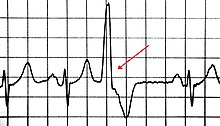| Premature ventricular contraction | |
|---|---|
| Other names | Premature ventricular complex, ventricular premature contraction (complex or complexes) (VPC), ventricular premature beat (VPB), ventricular extrasystole (VES) |
 | |
| Premature ventricular contraction usually originates from an area of Ectopic focus. In this illustration ectopic area is near papillary muscles in the left ventricle. Most commonly in healthy hearts PVCs occur near right ventricular outflow tract (RVOT). | |
 | |
| A premature ventricular contraction on an EKG, marked by the arrow | |
| Specialty | Cardiology |
A premature ventricular contraction (PVC) is a common event where the heartbeat is initiated by Purkinje fibers in the ventricles rather than by the sinoatrial node. PVCs may cause no symptoms or may be perceived as a "skipped beat" or felt as palpitations in the chest. PVCs do not usually pose any danger.[1]
The electrical events of the heart detected by the electrocardiogram (ECG) allow a PVC to be easily distinguished from a normal heart beat. However, very frequent PVCs can be symptomatic of an underlying heart condition (such as arrhythmogenic right ventricular cardiomyopathy). Furthermore, very frequent (over 20% of all heartbeats) PVCs are considered a risk factor for arrhythmia-induced cardiomyopathy, in which the heart muscle becomes less effective and symptoms of heart failure may develop.[2] Ultrasound of the heart is therefore recommended in people with frequent PVCs.
If PVCs are frequent or troublesome, medication (beta blockers or certain calcium channel blockers) may be used. Very frequent PVCs in people with dilated cardiomyopathy may be treated with radiofrequency ablation.[2][1]
- ^ a b Gerstenfeld, EP; De Marco, T (20 August 2019). "Premature Ventricular Contractions". Circulation. 140 (8): 624–26. doi:10.1161/CIRCULATIONAHA.119.040015. PMID 31424993.
- ^ a b Akdemir, B.; Yarmohammadi, H.; Alraies, M. C.; Adkisson, W. O. (1 July 2016). "Premature ventricular contractions: Reassure or refer?". Cleveland Clinic Journal of Medicine. 83 (7): 524–30. doi:10.3949/ccjm.83a.15090. PMID 27399865.